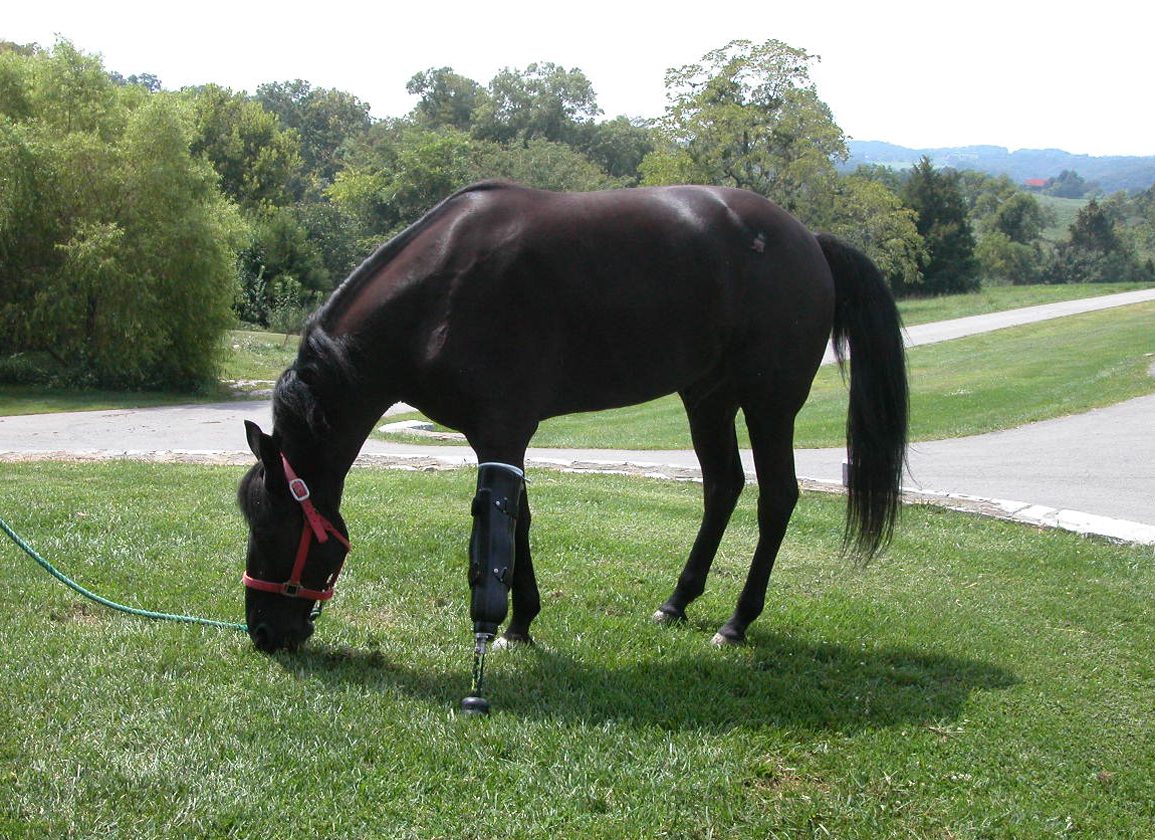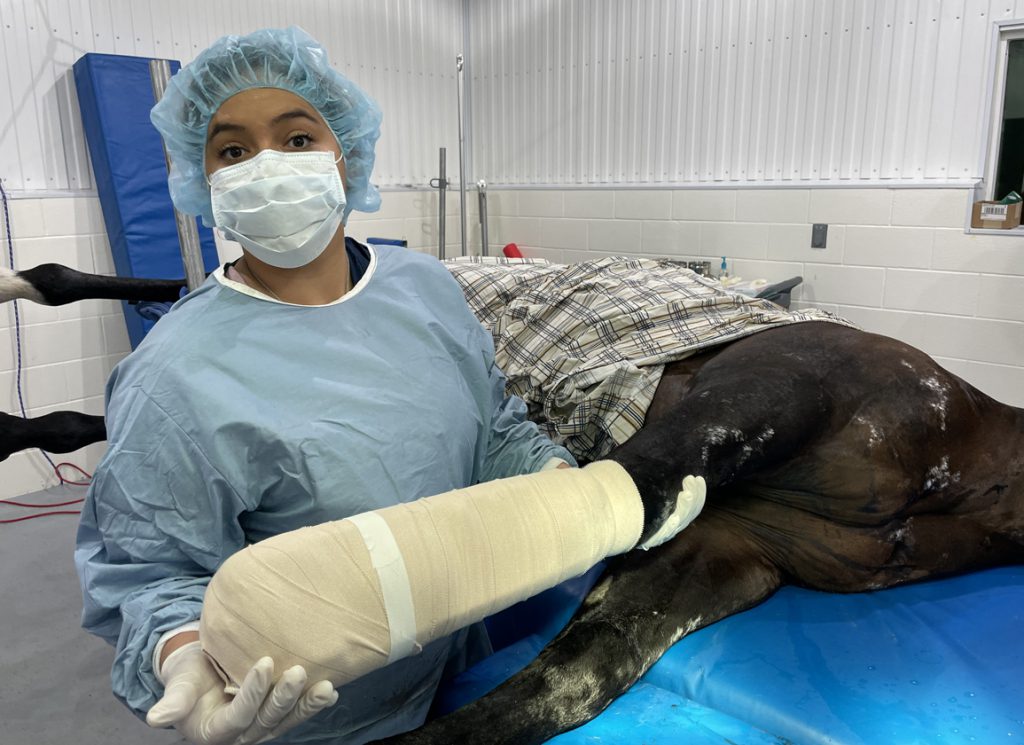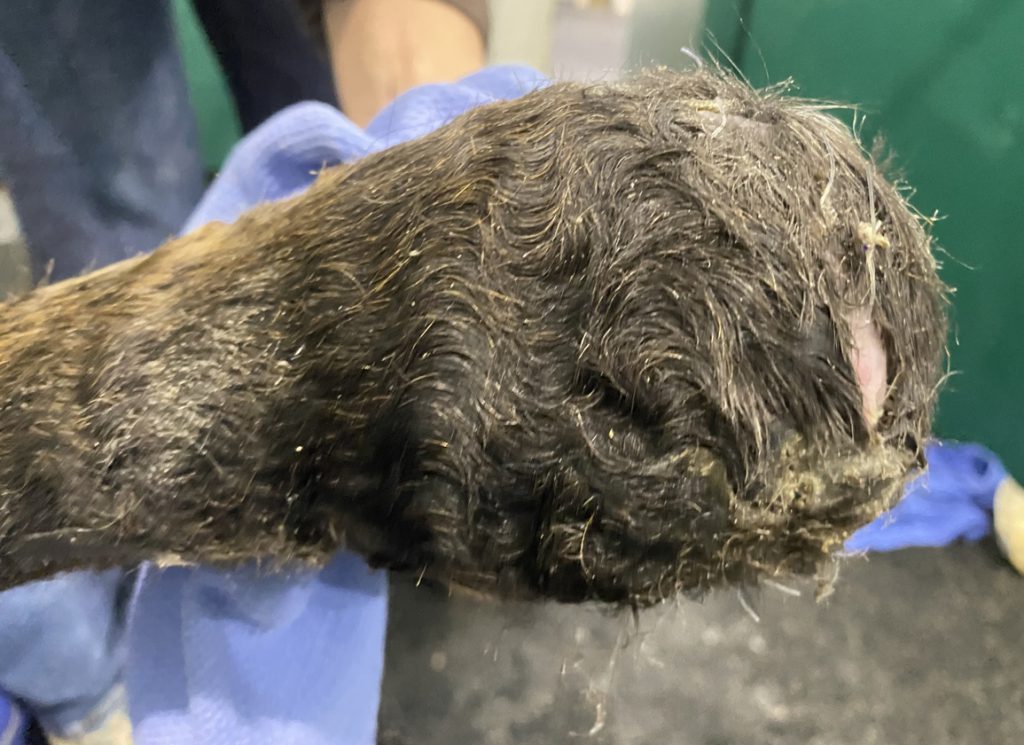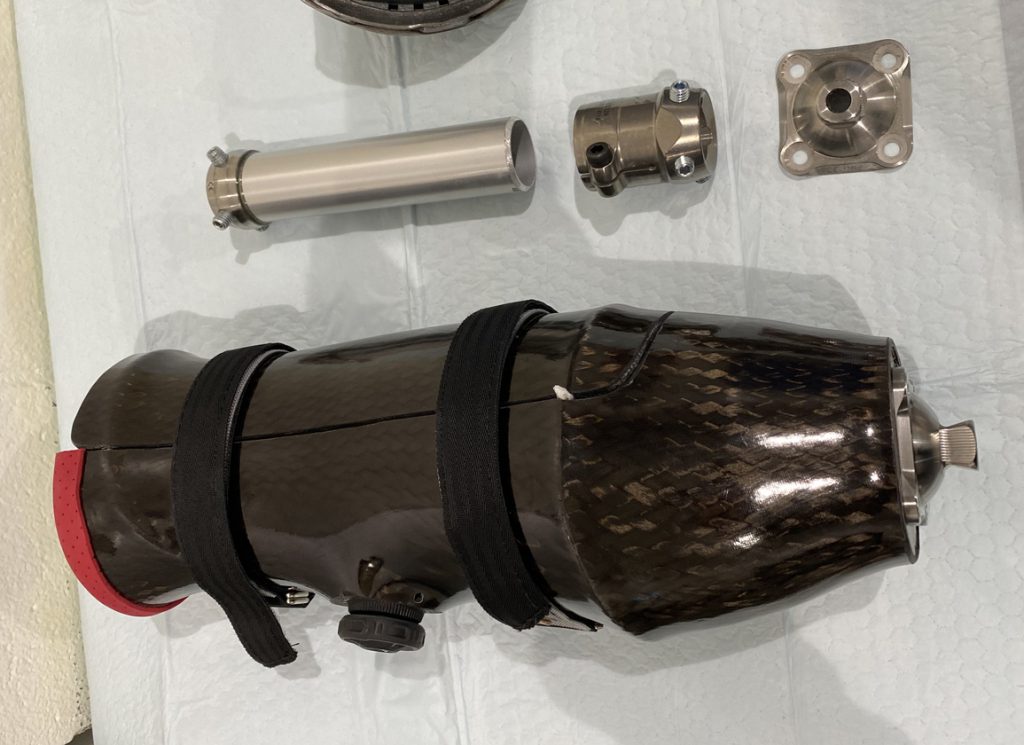By Dan Ross
There is a theme of reinvention running through Ian Gould's cephalopod-like business ventures.
His UK-based research and development company is looking to revolutionize the way electric vehicle batteries are re-processed, for example, and wants to recycle carbon fiber composite materials otherwise destined for the dump. His latest focus is on animals that suffer catastrophic limb injuries, those with a usually grim prognosis.
“We were looking at greyhounds at first,” said Gould-loquacious and enthusiastic, in the mold of a spirited science professor-over Zoom one recent evening UK-time.
But given the inherent threat of severe injury in racing, “we were thinking, given the advances in digital technologies, in 3D reverse modelling, we realized we could profile equines as well,” Gould added.
In Gould's telling, the idea is broken down into two main buckets. Firstly, a horse's entire physical make-up, inside and out, must be digitally mapped using a 3D laser scan and through bio-engineered x-rays.
“And we can hold that information in a database,” said Gould, pointing to another product in his company library, a digital pet passport accessed through an implanted chip.
In the event a racehorse suffers a catastrophic injury that cannot be saved through conventional surgeries-but which the attending veterinarians believe can be saved though prosthesis-the horse's specifications can be accessed through the chip, then used to print out on a 3D printer an accurate three-dimensional rendering of the required limb part.
“If the vet identified that there is a possibility to save the horse [with prosthetics], that part could be manufactured within hours through 3D printing,” said Gould, of a limb made from hybrid polymer materials strong enough to build jet aircraft.
The technology already exists to bring Gould's idea to life, but practicalities mean it's a long way still, if ever, from being realized in any broad fashion. What it taps into is a niche corner of equine veterinary practice-marginalized for various reasons.
One is the dearth of veterinarians equipped with the training, expertise and inclination to both perform the operation and oversee weeks of post-surgery critical care. Another is cost. Spoiler alert: It ain't cheap.
Another is all wrapped up in ethics: Just because you can do something, does it mean you should?
“Clients often bring friends to see their horse with them standing next to each other watching their horse with a full or half limb prosthesis fly around the paddock with other horses bucking and kicking,” said Lexington-based veterinarian, Ric Redden, who says he has performed more than 50 equine amputation surgeries in his long career. He's an ardent advocate for the surgery but understands how some remain skeptical.
“One says, 'wow, is this not amazing,' with happy tears running down their cheek. The other says 'poor thing, she doesn't have but three legs,' with tears in their eyes. There you go, nothing about horses or horse sports is for everyone,” he added. “But there is life after the leg comes off. That's the story.”
History
“It's been a long slow development on the history of prosthesis,” explained Barrie Grant, a long-time veterinary fixture at Southern California racetracks.
“People have been fashioning sticks and everything else at the end of stumps for years,” said Grant. “I've been over to Egypt. I worked down in Ramses's tomb. I didn't see any hieroglyphic of a horse missing one leg, but that doesn't mean it didn't happen back then.”
Whether or not those ancient Nubians ever fashioned some kind of alternative limb to any accident-prone early ancestor of the horse, a more recent “modern-day” report of equine prosthesis came in the early 1970s, explained Grant, when an appaloosa mare called Robin Dundee was equipped with a prosthetic limb at Washington State University (WSU).
When it comes to overlap with horseracing, Grant was involved in 1985 with one of the most high-profile cases of racehorse prosthesis-Boitron, an ex-European graded stakes winner trained in the U.S. by Wally Dollasse.
Boitron's troubles began at stud, with an abscess in the lining of his right-hind hoof wall. The abscess worsened, ultimately necessitating removal of the whole foot.
Gradually, though, residual problems and infections worked their way up the leg, until eventually Grant and his team at WSU removed the bone to four inches below the hock, wrapping the skin and the superficial flexor tendon around the stump to provide cushioning.
Boitron was fitted with a permanent prosthetic leg, and eventually returned to stud duties at a farm near California's Central Valley coastline. He would end up covering mares until five years later when he died from complications through a stomach abscess that led to peritonitis.
Since the experimental days of Boitron's travails with limb loss, technical advances have been made to the whole procedure. Grant specifically champions the work in this field of veterinarian Donna Harper.
Indeed, Ted Vlahos, a Wyoming-based veterinarian who has performed or overseen virtually over 100 such surgeries, describes a process of refinement to his approach over the past 20 years.
“People always ask, “oh, you'll have to have the horses recover for weeks in a sling,'” said Vlahos, pointing to what he calls a common misconception.
“That is not necessary,” he added. “We don't have a sling in our facility anymore. We stopped using it for amputees and found it completely unnecessary.”
Rather, horses at Vlahos's clinic are expected-like humans with new knees and hips-to move around right away on a temporary prosthetic, and to get up in the recovery room unaided. “We want them as normal as possible,” he said.
So, what does the whole surgical process resemble today?
How it Works
The highest Vlahos has amputated is to the mid-radius of the front leg, and to the upper cannon bone in the hind leg. “But the vast majority of cases-probably 90% of the ones we have done-have been at the fetlock and below,” Vlahos said.
“We will typically in a distal limb case amputate at the fetlock and preserve the sesamoids bones,” said Vlahos, adding that sesamoid bones can still be left in place, even if fractured (a common catastrophic injury in racehorses).
“If we can, it's very important to preserve the sesamoid bones when we do our closure as that makes for a bulbous end on the distal limb so the prosthesis won't slip off,” he added.
Blood flow is vital for the tissue and any supporting tendons to be safely closed over the stump, and Vlahos removes sensation of that area by performing an “aggressive neurectomy” so the horses “don't feel their stump,” he said, describing this as a typical process in humans. “We actually take about 3 inches of nerve from the fetlock.”
Surgery will usually range between one and a half to two hours, a difference largely defined by whether or not Vlahos inserts “transfixation pins”-a concoction of metalwork to help alleviate weight-bearing on the stump in the initial post-surgery period.
Unlike humans, whose stumps must heal before a prosthesis is fitted, a horse is put into a temporary prosthetic leg immediately, before transport to the recovery room. “They have to walk on it right away out of recovery,” said Vlahos.
“In most of our cases if the horse is healthy enough to accommodate a transfixation cast, we will place two threaded pins in the bottom third of the horse's cannon bone and incorporate that into a transfixation cast,” said Vlahos. “That is something we've used in fractures and founder cases for many years.”
The thinking behind the transfixation pins and cast boils down to this: When the horse stands upright, the weight in the removed limb is transferred down through the cannon bone to the pins-which stick out each side of the leg about an inch-down through the cast, to which the temporary prosthesis is attached, and then to the ground.
“That allows the horse to fully load on the leg but not put any pressure on the stump,” said Vlahos. “This facilitates stump healing.”
As horses acclimatize to their foreign limb, there of course exists the worry that a horse will injure itself or damage the transfixation cast as it scrambles to its feet.
However, “the risk of limb failure in recovery is no greater than other procedures,” Vlahos said, adding that he has never had a limb fracture in recovery from a transfixation cast in 35 years of surgery.
The temporary prosthesis comes with a bulbous end to negate torque as the horse moves around the recovery room. “We have that fabricated at our welding shop, and it's basically a little round cup with straps that go up the leg,” said Vlahos.
Horses remain in this temporary prosthesis until the stump heals-what generally takes about a month-at which point, the patient will be fitted for the permanent prosthesis, necessitating a mold of the leg. This takes about two weeks to manufacture.
Intriguingly, Vlahos typically halts pain medications after 48 hours, but will keep them on antibiotics or antimicrobial agents for two to three weeks. In all, the horses typically remain at the clinic for about six to eight weeks.
Problems
Given the practicalities of managing lameness, a fair assumption would be that the biggest hurdle to successful post-surgery recovery would be support limb laminitis-lameness transferred to the good leg as the horse shifts its weight away from the problem limb.
Vlahos downplays the threat posed by support limb laminitis, though encourages constant mindfulness of its threat. But in pre-existing chronic cases where support limb laminitis was already at play, “What we found was, by removing the painful limb, the support limb laminitis resolved in most horses,” he said.
Redden, who helped in the initial stages of Boitron's surgical odyssey, similarly emphasizes the need for vigilance in the post-surgery period for support limb problems.
“You can't be looking at them over the stable door waiting for them to tell you if something's wrong,” he warned.
The trick, said Redden, is to support the good leg with devices like a “Mega Ultima“-a high level mechanical aid that can reduce the load on the deep flexor tendon about 60-65%-and to routinely monitor vascular supply to the foot. The mega ultima is technique sensitive, stressed Redden, and requires radiographic control.
Rather, Vlahos and Redden both identify the quality of care horses receive over the long-haul as one of the most instructive factors to post-surgery success and longevity of life.
Once the stump has healed and the permanent prosthetic has been fitted, the new limb still needs to be changed as frequently as every day if the horse is in a hot climate, or every few days somewhere colder. It's a quick process that Vlahos says takes less time than cleaning out all four feet.
Pressure sores at the stump remain a continuous concern, explained Vlahos. The permanent prosthetic will need periodic adjustments and will have to be fully replaced every two to three years. When turned out, the paddock must be essentially child-proofed to ensure the prosthetic won't snag or catch. Steep slopes and muddy patches are discouraged, for example.
“The daily attention you need to give the horse is incredible,” said Redden.
Ethical Considerations
Which partially explains why so few of these operations are conducted. Another is money.
Vlahos breaks the price-tag down this way: Between $8,000 and $10,000 for the surgery, post-surgery aftercare between $200 and $300 a day (for roughly two months), and the permanent prosthesis priced between $2,500 and $3,000.
Gould estimated that 3D rendered limbs-both the temporary and permanent prosthesis-could come with the combined cost of between $12,000 and $25,000.
But perhaps the greatest reason why equine prosthesis remains such a niche veterinary procedure boils down to ethics and optics.
Respected British publication the Horse & Hound has posted various articles in recent years broadly condemning the procedure, for example, with the publication's resident veterinarian quoted as being “horrified” by a video shared on social media of a horse in Columbia fitted with a prosthetic limb.
“It's hard for me to comment on something that I've never seen done,” said Ryan Carpenter, a Southern-California based veterinarian instrumental over the past few years in a fetlock arthrodesis surgery program-a procedure to stabilize the ankle, preventing joint movement by fusing it into a normal position for the leg-when asked about the procedure.
“But it's the same for any program: What's in the best interest of the horse? We have to be able to look back at these horses after six months or a year and say, 'are we doing the right thing or not?'” he added. “What we've seen with the arthrodesis program is they do remarkably well, and we're actually very happy and proud of our outcomes.”
So, what does Vlahos consider a successful amputation surgery? “Can that horse have a quality of life, maintain their body condition and serve their purpose, whether that be as a pasture animal or a breeding animal?”
In a 2005 study, Redden and Vlahos reported the findings from 26 amputation cases, with 73% surviving the 120 day post-operative period and 65% surviving at least nine months, the latter of which described as “serviceably sound as breeding or companion animals.” Mean overall survival time was 30.6 months.
Over his 100-plus cases to date, Vlahos pins the figure at 90% of horses surviving discharge and comfortable at more than 12 months. Fewer than a handful of horses failed to survive to discharge, he added, tripped up by things like septic limbs and complications during anesthesia.
“Our experience has been they live a normal life, if cared for properly,” said Vlahos, pointing to videos posted on his website. “We have horses that have spent between 15 to 20 years since surgery out running happily in pastures and being serviceable breeding animals.”
As a recent success story from the racehorse world, Vlahos points to the Quarter Horse stallion Triple Vodka, fitted with a prosthetic after a septic coffin joint in his right front necessitated amputation below the fetlock. Triple Vodka returned to full stallion duties, said Vlahos, but passed away last fall through complications from a twisted colon.
In a 1985 article in the Blood Horse on Boitron's surgeries, Grant is quoted as saying that he hoped the horse's exploits would spur copy-cat surgeries. “We were lucky with Boitron,” Grant said at the time. “If he hadn't made it, a lot of skeptics would say don't bother trying anymore.”
Nearly forty years later, however, Grant laments how few believers his proselytizing has converted. “Personally, one of the unfinished things I put in my bucket, I guess, is trying to get more people to think about doing it.”
Future
Which brings us back to the prosthetic limb itself, and its evolution from bygone days of stumps fashioned from wood cuts.
Boitron's foreign limb was ostensibly jimmy-rigged: A steering column from a Volkswagon vehicle mounted along two stainless steel tubes atop on a foot plate and support cup.
Modern iterations used by Vlahos consist of titanium pylons-some with shock-absorbers incorporated-surrounded by graphite laminate or hard plastic and mounted on a stainless-steel foot plate.
To help alleviate pressure sores at the stump, Vlahos inserts a gel cushion into the lining of the prosthesis. With a similar aim, Redden graphs frog tissue to the stump.
And for the past two years, the addition of a Boa cable system to the permanent prosthetic has enabled a more secure fit to the leg, in the style of a ski-boot, allowing for a lighter prosthetic. “This helps prevent the prosthetic from falling off, even at full gallop,” said Vlahos.
The materials used, however, are intended for human use. “So, they're meant for up to a 350lb person per leg,” he said. Which circles back to Gould's vision of the future.
The 3D rendering, he said, could be made accurate in size, weight and proportion to not only the part of the limb removed but to the corresponding leg as well, to act as a necessary “counter balance.” Why is this important?
“Taking the profile of the animal, we can take the dimensions of the other leg that isn't damaged, and say, 'it's got to be within grams of the same weight and the same composition and bone structure as the leg we're already fixing. It has to be. If I was to dissect my legs, they would weigh virtually the same,” said Gould.
“The way the brain operates is that it has already been pre-programmed for the weight of my arms, the weight of my legs, and the pressure I put on each of those things,” he said. “There's a lot of areas that we can tailor to the specific horse.”
Of course, the most accurate rendering of a horse's limb would replicate its full range of motion. Right now, Gould's 3D rendered limb would be a static object.
Eventually, however, “we can, though further engineering, insert into it moving parts and compounds,” he said, pointing to significant advances already made in human prosthetics.
And where does Gould stand on the ethical question: Should veterinary science be pursuing this?
“It's probably only been the last three to five years where analytical data and big data streams have become more prominent,” said Gould, emphasizing how sound evidence-based statistical knowledge can be used to compliment veterinary science, and racehorse health and welfare in general. “Big data is the new frontier.”
Not a subscriber? Click here to sign up for the daily PDF or alerts.









